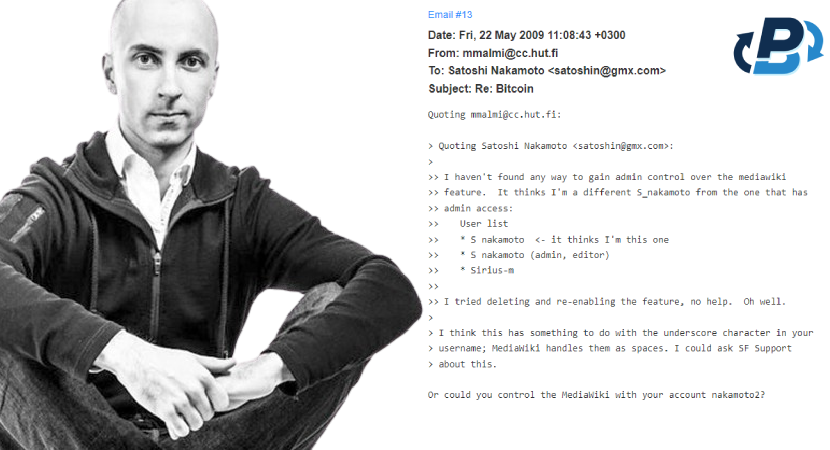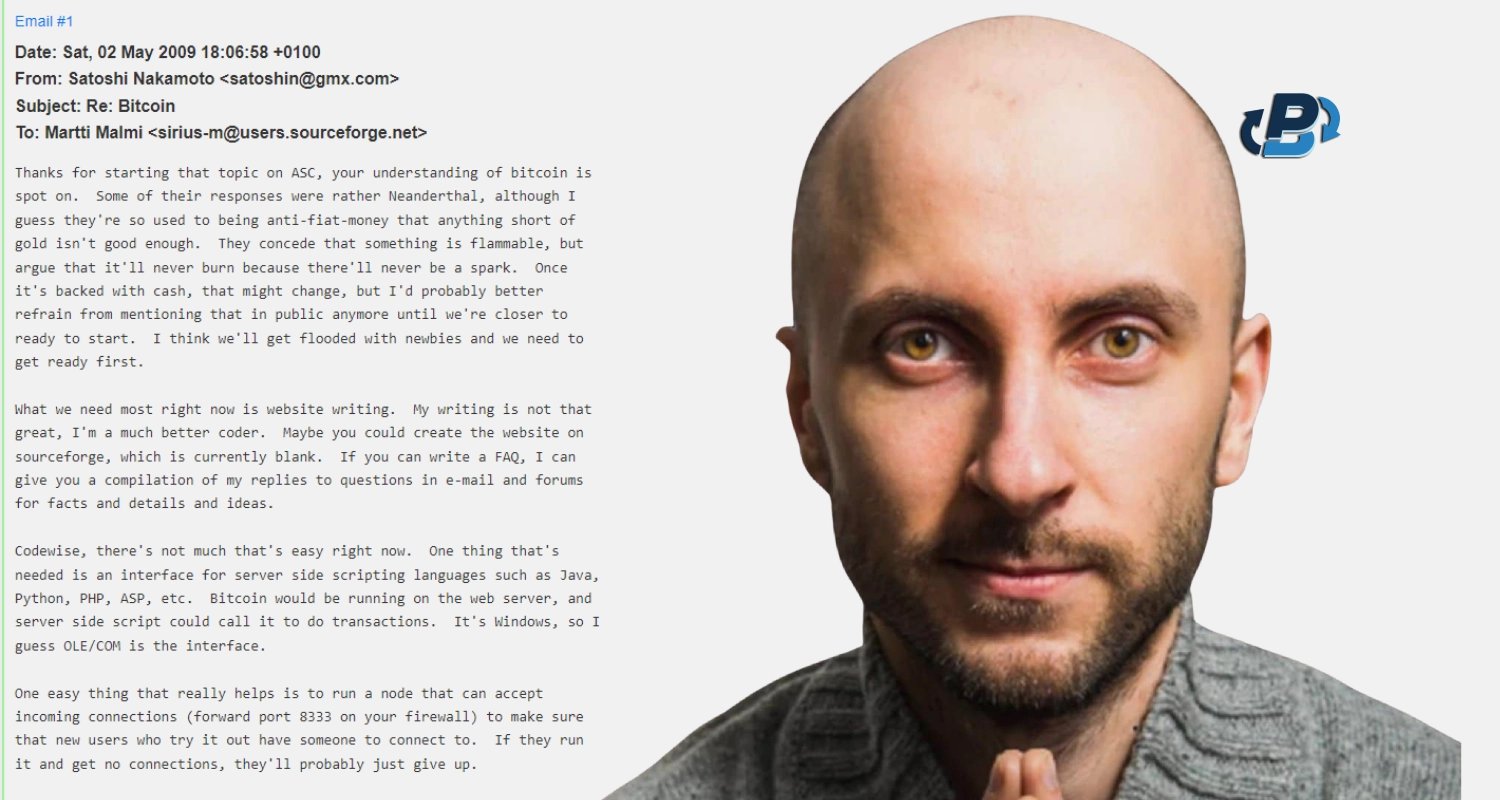Finnish software developer Martti Malmi has published his entire email correspondence with Bitcoin’s anonymous creator in the Martti Malmi Satoshi emails, which were published during the testimony of Martti against Greg Wright in 2024, who claimed he is Satoshi Nakamoto, to showcase the correspondence between Martti and Satoshi from May 2009 till February 2011. Some of the topics that were discussed in the 260 emails were Bitcoin scaling issues, the non-wasteful nature of its mining process, their vision on time-stamping, concerns about promoting Bitcoin, Digicash, the evolution of Bitcoin trading, comparing traditional credit card networks vs. Bitcoin. Before our experts dive into the interesting content exchanged in the leaked emails, let’s take a look at some crucial background information about both software developers.
Who is Martti Malmi?
Martti Malmi, aka ‘’Sirius’’ or ‘’Sirius-M’’ is a Finnish software developer who contributed to the Bitcoin project from 2009 to 2011. Allegedly, he worked with other well-known figures in the early days of Bitcoin, such as Hal Finney and Gavin Andresen. Additionally, he was one of the first to openly advocate Bitcoin's ideological standpoints through anti-state.org. Martti Malmi was born in 1988 and allegedly could program computers from the age of 12. He studied computer science at the University of Helsinki and was ideologically aligned with the Swedish ‘’Pirate Party.’’ In 2008, Martti Malmi was the first person to conduct a crypto-to-fiat transaction with the sale of 5,000 of his saved bitcoins for just over $5. According to insiders, Martti Malmi was the first cryptocurrency exchange owner, and he functioned as the main market maker for it, with 30,000 of his own bitcoins as well.

The Anonymous Identity of Satoshi Nakamoto
Satoshi Nakamoto is the name used by the pseudonymous person or group of people who have developed Bitcoin, authored its official white paper, and worked on the first blockchain database. Although there has been widespread speculation about Satoshi Nakamoto’s true identity, nobody knows who it is/they are. The Nakamoto name has etymologous roots in Japan, but most experts in the matter speculate that the cryptographer was of US or UK origin. Although Nakamoto has never revealed any personal information and claimed to be a 37-year-old Japanese man, experts have speculated the ‘’genius’’ behind Satoshi Nakamoto is either Hal Finney, Dorian Nakamoto, Nick Szabo, Craig Wright, or others. The anonymity of Satoshi Nakamoto brings us to the reason why the Martti Malmi Satoshi emails were released and made publicly accessible in the first place.
The Subjects Discussed Between Martti and Satoshi in Their Correspondence
Satoshi Nakamoto and Martti Malmi sent emails to each other because Satoshi entrusted Martti with Bitcoin’s group of core developers and initially assigned them to compile all texts available on Bitcoin.org, explaining the project to the greater public. Nakamoto understood that Martti had vast knowledge of Bitcoin’s inner workings and acknowledged that he would be able to verbally counter the broader community's initial skepticism towards Bitcoin. Besides, he appreciated Martti’s effort in upgrading Bitcoin’s website and advising him on the required core features for the overall Bitcoin project. It is known that Satoshi Nakamoto relied heavily on Malmi for his writing.
Traditional Credit Card and Banking Networks vs. Bitcoin
In one of their early emails, sent on May 3, 2009, Satoshi wrote to Martti that the existing Visa credit card network could process around 15 million Internet purchases daily globally and that Bitcoin could already scale much larger than that using existing hardware at a fraction of the cost. Additionally, he added that Bitcoin technically had no scaling ceiling and that if Martti were interested, Satoshi would tell him how it could scale and cope with extreme size and usage. According to Satoshi, Bitcoin’s Proof-of-Work (POW) consensus mechanism consumes less energy than the traditional banking system and is the only solution that can make a Peer-to-Peer electronic cash system work without the need for any third-party intervention. Satoshi also added in his email correspondence with Martti Malmi that he’d like to emphasize the anonymous nature of Bitcoin. He stipulated that although the project used Bitcoin addresses instead of IP addresses, they should not give the impression that its usage is automatically fully anonymous. Rather, it is possible for users to be pseudonymous, but they have to be careful and use their intuition.
Satoshi and Sirius on Time-Stamping
In a different series of emails, Satoshi Nakamoto and Sirius-M discussed Time-stamping, which entails the ability to prove a file or document existed at a certain time in the past or that a certain transaction of data took place. A good example of a real-world use case of time stamping is Guatemala’s elections, which have been certified by blockchain technology in recent years. Additionally, Malmi and Satoshi discussed the compensation of computational effort and wattage usage compared to the rewards regarding Bitcoin mining.
Bitcoin Doesn’t Waste Energy
One of the most interesting emails between Martti Malmi Satoshi and Satoshi Nakamoto covered the topic of Bitcoin’s energy usage. Critics on the Bitcoin.org forums found Bitcoin mining to be a waste of energy, and Satoshi wrote Malmi that not having a currency like Bitcoin would be a bigger waste to mankind. In the emails, Satoshi expands more vividly on the idea and in more detail, stating that Bitcoin supporters should opt for Proof of Work whenever having to choose between economic liberty and conservation. He also added that Proof of Work (POW) is fundamental in coordinating the Bitcoin network and counter double-spending and that Peer-to-Peer (P2P) e-cash can only work without any external third party. Additionally, he stipulated that even if Bitcoin mining became extremely energy-consuming, it would still be less wasteful compared to the labor and resource-intensive conventional banking activity it would potentially replace.
Digicash Discussed
Another interesting topic that was often discussed by Malmi and Nakamoto was Digicash, David Chaum’s failed e-money, and its differences and similarities with Bitcoin. More specifically, the differences in privacy properties of the two models and that Bitcoin was superior to Digicash because it didn’t require users to be online to make use of its peer-to-peer system. Additionally, Satoshi describes the deflationary workings of Bitcoin, stating that there is a limited supply of money, with its circulation being capped at 21,000,000 coins and transactions only transferring ownership. Sato explains in the leaked emails that to protect the privacy of its users, Bitcoin key pairs can only be used once, with a new one being created for each transaction. The owner of a Bitcoin is whoever has its private key. Crucial to these features is the lack of a central server, which counters the proverbial Achilles heel of Chaumian systems, where the currency shuts down whenever the central company does.
Satoshi’s Bitcoin Promotion Concerns
In another series of emails, Satoshi expressed his concerns regarding the promotion of Bitcoin and labeling it an investment. He wrote to Martti that ‘’it is a dangerous thing to say’’ and that Martti should remove its bullet point on the Bitcoin.org website where he was the head copywriter. Satoshi also briefly mentioned that section 2.3 of the FAQ wasn’t optimal and that links to sites helping to set up 8333 port forwarding would be great. However, the most interesting part of this email series is that Satsohi, at one point, mentions that someone came up with the word ‘’cryptocurrency’’ and that he asks Martti whether he liked it when describing Bitcoin. This indicates that Satoshi hasn’t dubbed Bitcoin as cryptocurrency himself.
Discussions on how Bitcoin Trading Would Evolve
Satoshi and Malmi also discussed how Bitcoin trading would eventually evolve. Both knew that Bitcoin was relatively easy to obtain in the beginning, as anyone could mine it from their computer. Satoshi indicates that people might be skeptical at the beginning of Bitcoin’s value and that increasing the mining difficulty would prove its scarcity to users. Satoshi wrote, ‘’Offering currency to back Bitcoins would attract freebie seekers, with the benefit of attracting a lot of publicity.’’ He also outlines that keeping the minimum transaction size above a certain amount, which a typical user would accumulate with one’s computer at the time, makes trading easier. However, we can almost be 100% certain that both Satoshi and Malmi didn’t expect Bitcoin to become as popular as it is today. Little did they know that stuff like ‘’wash trading’’, ‘’honey pots’’, and ‘’rug pulls’’ were going to be so rampant in today’s day and age.
Satoshi Burning Out on Bitcoin
During the final email conversations in July 2009, Satoshi indicated he was tired and needed a break from Bitcoin, with the main reason being Hal Finney being absent for over 18 months from the project. On a side note, Satoshi asks Malmi whether he knows any applications people could actually use Bitcoin for. Specifically, Satoshi mentions that he hadn’t been able to get the Sourceforge login page to load and that he wasn’t able to read it either. Another thing Satoshi stipulated was that Hal Finney had helped him a lot in defending the original design on the Cryptography List. Additionally, he praised Finney for releasing his Reusable Proof Of Work (RPOW) consensus mechanism. Ironically, Hal Finney died on August 28, 2014, due to the result of complications of ALS (Amyotrophic Lateral Sclerosis). Luckily, he was cryopreserved by the Alcor Life Extension Foundation. To this day, we don’t know anything about Satoshi Nakamoto's true identity or his or her physical and/or emotional well-being. In fact, technically, we don’t even know if Satoshi is still alive.
Why was the Correspondence Released?
The Martti Malmi Satoshi emails were released because the Crypto Open Patent Alliance, a non-profit cryptocurrency organization aiming to prevent patent hoarding and obstruction innovation, launched a claim against Craig Wight, who claims to be Satoshi Nakamoto and the inventor of the Bitcoin system. In this significant court case, Martti Malmi, better known as Sirius, published his email communications with Satoshi because he was a key witness who could prove Craig Wright was not Satoshi Nakamoto. In March 2024, after a six-week trial, Justice Mellor ruled that Craig Wright wasn’t Satoshi Nakamoto and that he didn’t write the official Bitcoin White Paper either. Additionally, the judge ruled that Craig Wright is not the author of the early versions of the Bitcoin software or the person who created the Bitcoin system.
Satoshi Nakamoto’s Disappearance
As you might know, Satoshi Nakamoto disappeared in 2010. In email conversations with Martti Malmi, he states that he is busy with other things, recalls the code was nearly ready for its 0.3 release, and that it required a little extra testing time to install the new icon. Additionally, he told Malmi that it would make sense to build a practical application with the API before officially releasing it. Apart from disappearing himself, Satoshi Nakamoto already expressed his concerns regarding Bitcoin’s privacy in earlier emails sent to Martti Malmi. In these email conversations, Satoshi stipulated the problems anonymity could cause for the Bitcoin Project, such as KYC laws and other legal pitfalls. Most of these anonymity problems are still a great deal today and provoke heated discussions on forums, DeFi crypto community pages, and IRC chat rooms.
Donations to Further Bitcoin Development
In June 2010, an anonymous donor offered Satoshi $2,000 for his project. Satoshi, on the other hand, had the donor send the money to Martti instead, stipulating that the donor’s anonymity should be kept at all times. The donation money was to be spent covering web host costs and back the costs of exchange services. Fast-forward to 2024. In all these years, nobody has been able to track down this gullible anonymous donor. However, it must be said that this isn’t entirely necessary either, as we can be quite sure Satoshi repaid the donation or that the donor was an early investor who probably made good money by being an early Bitcoin adopter.
Martti Malmi’s Role in the Early Days of Bitcoin
Now that we have highlighted some of the topics discussed by Satoshi and Martti in their email communications and what these conversations tell us about the potential identity of Satoshi, our experts are going to take a closer look at Martti Malmi’s role in the early days of Bitcoin development. In a nutshell, Martti Malmi wrote almost all original text on Bitcoin.org, the first website that covered the Bitcoin project. Additionally, Martti was the only developer to work on the Bitcoin Core software apart from Satoshi. Martti discovered Bitcoin as early as 2009, when it was still in its infancy. He began mining the coin from his PC and assisted Satoshi with code reviews. According to the emails, Satoshi personally thanked Martti multiple times for fixing bugs and adding features to Bitcoin’s main website, Bitcoin.org. However, Martti Malmi’s role in the early days of Bitcoin development doesn’t end there. Martti regularly addressed the Bitcoin community on updates, core development changes, and the project and its founder’s vision.
What the Martti Malmi Satoshi Emails Tell Us About Satoshi’s Likely Identity
Associate Professor Clark at Canada’s Concordia University was struck by Satoshi’s language in the leaked emails. After carefully analyzing Satoshi’s language usage, he concluded that Satoshi wasn’t hesitant to swear generally, that he is probably Southern USA-based, and maybe grew up religious. Additionally, Clark assumes Satoshi isn’t super old as he uses slang like sweet, newbies, suck, screwed, and goofball, indicating he was probably born in the early 1980s. Another interesting fact Clark noticed was that Satoshi wrongly used the word ‘’loop’’ in Bitcoin’s source code, which is a word very rarely used in programming languages, indicating that Satoshi might have worked in the telecom industry instead. This is further underlined by the fact that when Satoshi decided to withdraw himself from day-to-day Bitcoin-related activities, Malmi played a crucial role in finding his replacement. Satoshi mentioned Gavin Andresen and told Malmi that he trusted him and that he was technically much more Linux-capable than himself.
Conclusion
Now that we have access to the emails sent between anonymous Satoshi Nakamoto and one of Bitcoin’s earliest core developers, we might be closer to finding out the true identity of the most famous cryptocurrency’s creator. However, should we even care about this at this point? The leaked emails definitely helped eliminate candidates, which is partially the reason why Martti Malmi attended the trial and exposed them. However, there are not enough public facts known about Satoshi to accurately identify him based on what we currently know, according to experts on the matter. In the end, we may never get to know Satoshi Nakamoto’s real identity, and perhaps this shouldn’t matter either. It is Bitcoin as a whole and its respective blockchain technology that is important, transcending into individual, corporate, and government use cases.







